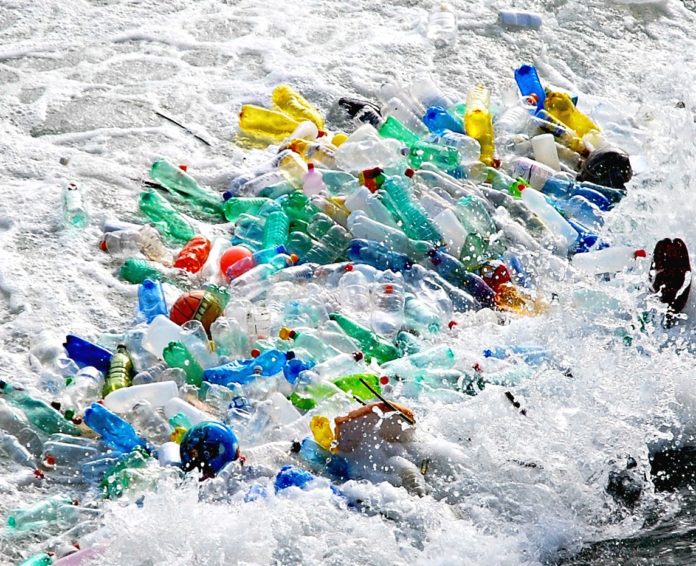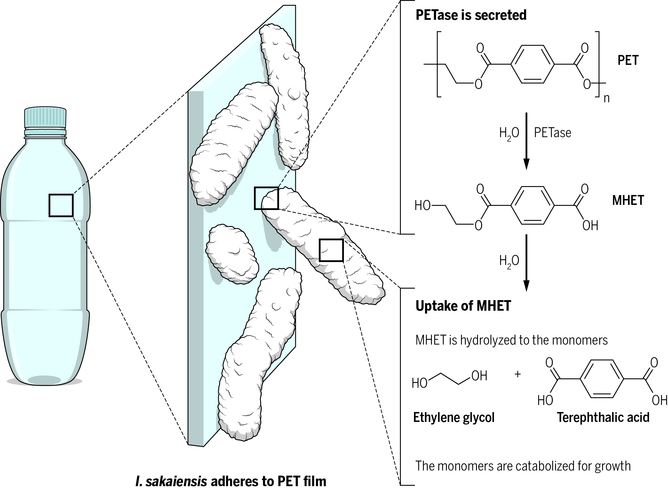
The new species, Ideonella sakaiensis, breaks down Polyethylene Terephthalate (PET) – used extensively worldwide to package bottled drinks – by producing two enzymes capable of hydrolyzing PET and the reaction intermediate, mono-(2-hydroxyethyl) terephthalic acid – MHET for short. Both enzymes, according to Japanese scientists, are required to enzymatically convert PET efficiently into its two environmentally benign monomers, terephthalic acid and ethylene glycol. Terephthalic acid and ethylene glycol are then used by the bacteria as an energy source.
For five years, the researchers collected 250 samples of PET debris from soil and wastewater from a PET bottle recycling plant in Sakai, Japan. They scanned these samples for bacteria that could eat PET and discovered that Ideonella sakaiensis could fully break down a thin film of low-grade PET after six weeks at a temperature of 30°C.
Genetic and biochemical analyses identified two key enzymes involved in the breakdown of PET. One enzyme worked with water to break down the plastic into an intermediate substance, which the other enzyme broke down into PET’s basic building blocks, the scientists said.
Study co-author Kohei Oda, an applied microbiologist at the Kyoto Institute of Technology in Japan, commented:
“The bacterium is the first strain having a potential to degrade PET completely into carbon dioxide and water… In the future, we would like to “improve the ability of the microorganisms to degrade. We hope that we can develop a technology to handle such a lot of wasted PET.”
Scientists have long searched for a biological agent that could effectively degrade PET’s tough crystalline structure. However, they had only found a few species of fungi that could partially break down the plastic. The discovery of Ideonella sakaiensis is, therefore, a step in the right direction. An elated Oda said:
“I was very surprised to find micro-organisms that degrade PET, because so far, it has been said that PET is a non-biodegradable plastic.”
Natures way of fighting back? “Could a new plastic-eating bacteria help combat this pollution scourge?” https://t.co/BbtnDHbvqJ
— Pooja Bhatt (@PoojaB1972) March 11, 2016
While the new discovery holds exciting possibilities for the harmless breakdown of PET, lead author Dr Shosuke Yoshida said that it was not as simple as unleashing armies of PET-metabolising bacteria into landfills to break down waste plastic.
“Because of its crystal structure, the rate of degradation is very slow. However, after heat-treatment at 260 degrees, the crystal structure breaks down, allowing these micro-organisms to easily decompose the plastic.”
Insisting that the enzymes and processes would need refinement before they could be useful for industrial recycling or pollution clean-up, Professor Kenji Miyamoto from Keio University, one of the authors of the study, remarked:
“It’s difficult to break down highly crystallized PET. Our research results are just the initiation for the application. We have to work on so many issues needed for various applications. It takes a long time.”
PET is the most recycled plastic in the US but recycling rates still only reach about 31% nationwide. The European Union recycles roughly half of its PET. Even so, tens of millions of metric tons of the plastic wind up in landfills each year, where the polymer’s strong ester bonds resist breakdown.
According to the World Economic Forum, PET makes up almost one-sixth of the world’s annual plastic production of an estimated 342 million tons. Despite PET being considered one of the world’s most environmentally damaging but also one of the more commonly recycled plastics, the World Economic Forum reports that only just over half is ever collected for recycling and far less actually ends up being reused.
Scientists say it’s too late to clear ocean plastic https://t.co/X9KZvjJMgJ Sign to say no: https://t.co/BShmyQlBkh pic.twitter.com/VAULm3lUpg
— Greenpeace (@Greenpeace) March 7, 2016
It’s thought that plastic bottles take 450 years to break down, and although some plastics do degrade quicker in the ocean, this just leads to more chemical pollution. In 2010, eight million tons of plastic trash ended up in the ocean from coastal countries. If the ongoing practice of dumping plastics continues, the WEF recently warned, there will be more plastic than fish calculated by weight in the world’s oceans by 2050.
This plastic bottle says it better than I ever could. PLEASE stop buying #bottledwater. TY. The Ocean is dying. pic.twitter.com/0wYv615kZK
— Paul Jimerson (@pauljimerson) March 12, 2016
Discovery of Ideonella sakaiensis could be really good news for the environment considering the fact that our plastics are now littering the streets, filling landfills and cluttering up the oceans. As Science Alert observes:
This opens a whole new approach to plastic recycling and decontamination. At present, most plastic bottles are not truly recycled. Instead they are melted and reformed into other hard plastic products. Packaging companies typically prefer freshly made ‘virgin’ plastics that are created from chemical starting materials that are usually derived from oil.
The PET-digesting enzymes offer a way to truly recycle plastic. They could be added to vats of waste, breaking all the bottles or other plastic items down into easy-to-handle chemicals. These could then be used to make fresh plastics, producing a true recycling system.
This Article (Scientists Discover Plastic-Eating Bacteria That Can Save Our Planet) is free and open source. You have permission to republish this article under a Creative Commons license with attribution to the author and AnonHQ.com.






We can only pray that our Authoritys will insist these remedies are thoroughly checked out before they allocate huge amounts of our money to pay for huge quantities of the stuff and start gleefully splashing it about the place. On the other hand maybe we could make a real effort and stop creating toxic junk and dumping it in our oceans.